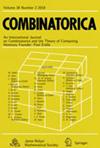Christos A. Athanasiadis
求助PDF
{"title":"局部h多项式,一致三角剖分与实数根","authors":"Christos A. Athanasiadis","doi":"10.1007/s00493-025-00162-2","DOIUrl":null,"url":null,"abstract":"<p>The local <i>h</i>-polynomial was introduced by Stanley as a fundamental enumerative invariant of a triangulation <span><span style=\"\"></span><span style=\"font-size: 100%; display: inline-block;\" tabindex=\"0\"><svg focusable=\"false\" height=\"2.013ex\" role=\"img\" style=\"vertical-align: -0.205ex;\" viewbox=\"0 -778.3 833.5 866.5\" width=\"1.936ex\" xmlns:xlink=\"http://www.w3.org/1999/xlink\"><g fill=\"currentColor\" stroke=\"currentColor\" stroke-width=\"0\" transform=\"matrix(1 0 0 -1 0 0)\"><use x=\"0\" xlink:href=\"#MJMAIN-394\" y=\"0\"></use></g></svg></span><script type=\"math/tex\">\\Delta</script></span> of a simplex. This polynomial is known to have nonnegative and symmetric coefficients and is conjectured to be <span><span style=\"\"></span><span style=\"font-size: 100%; display: inline-block;\" tabindex=\"0\"><svg focusable=\"false\" height=\"1.909ex\" role=\"img\" style=\"vertical-align: -0.705ex;\" viewbox=\"0 -518.7 543.5 822.1\" width=\"1.262ex\" xmlns:xlink=\"http://www.w3.org/1999/xlink\"><g fill=\"currentColor\" stroke=\"currentColor\" stroke-width=\"0\" transform=\"matrix(1 0 0 -1 0 0)\"><use x=\"0\" xlink:href=\"#MJMATHI-3B3\" y=\"0\"></use></g></svg></span><script type=\"math/tex\">\\gamma</script></span>-positive when <span><span style=\"\"></span><span style=\"font-size: 100%; display: inline-block;\" tabindex=\"0\"><svg focusable=\"false\" height=\"2.009ex\" role=\"img\" style=\"vertical-align: -0.205ex;\" viewbox=\"0 -777 833.5 865.1\" width=\"1.936ex\" xmlns:xlink=\"http://www.w3.org/1999/xlink\"><g fill=\"currentColor\" stroke=\"currentColor\" stroke-width=\"0\" transform=\"matrix(1 0 0 -1 0 0)\"><use x=\"0\" xlink:href=\"#MJMAIN-394\" y=\"0\"></use></g></svg></span><script type=\"math/tex\">\\Delta</script></span> is flag. This paper shows that the local <i>h</i>-polynomial has the stronger property of being real-rooted when <span><span style=\"\"></span><span style=\"font-size: 100%; display: inline-block;\" tabindex=\"0\"><svg focusable=\"false\" height=\"2.013ex\" role=\"img\" style=\"vertical-align: -0.205ex;\" viewbox=\"0 -778.3 833.5 866.5\" width=\"1.936ex\" xmlns:xlink=\"http://www.w3.org/1999/xlink\"><g fill=\"currentColor\" stroke=\"currentColor\" stroke-width=\"0\" transform=\"matrix(1 0 0 -1 0 0)\"><use x=\"0\" xlink:href=\"#MJMAIN-394\" y=\"0\"></use></g></svg></span><script type=\"math/tex\">\\Delta</script></span> is the barycentric subdivision of an arbitrary geometric triangulation <span><span style=\"\"></span><span style=\"font-size: 100%; display: inline-block;\" tabindex=\"0\"><svg focusable=\"false\" height=\"1.912ex\" role=\"img\" style=\"vertical-align: -0.205ex;\" viewbox=\"0 -735.2 625.5 823.4\" width=\"1.453ex\" xmlns:xlink=\"http://www.w3.org/1999/xlink\"><g fill=\"currentColor\" stroke=\"currentColor\" stroke-width=\"0\" transform=\"matrix(1 0 0 -1 0 0)\"><use x=\"0\" xlink:href=\"#MJMAIN-393\" y=\"0\"></use></g></svg></span><script type=\"math/tex\">\\Gamma</script></span> of the simplex. An analogous result for edgewise subdivisions is proven. The proofs are based on a new combinatorial formula for the local <i>h</i>-polynomial of <span><span style=\"\"></span><span style=\"font-size: 100%; display: inline-block;\" tabindex=\"0\"><svg focusable=\"false\" height=\"2.013ex\" role=\"img\" style=\"vertical-align: -0.205ex;\" viewbox=\"0 -778.3 833.5 866.5\" width=\"1.936ex\" xmlns:xlink=\"http://www.w3.org/1999/xlink\"><g fill=\"currentColor\" stroke=\"currentColor\" stroke-width=\"0\" transform=\"matrix(1 0 0 -1 0 0)\"><use x=\"0\" xlink:href=\"#MJMAIN-394\" y=\"0\"></use></g></svg></span><script type=\"math/tex\">\\Delta</script></span>, which is valid when <span><span style=\"\"></span><span style=\"font-size: 100%; display: inline-block;\" tabindex=\"0\"><svg focusable=\"false\" height=\"2.013ex\" role=\"img\" style=\"vertical-align: -0.205ex;\" viewbox=\"0 -778.3 833.5 866.5\" width=\"1.936ex\" xmlns:xlink=\"http://www.w3.org/1999/xlink\"><g fill=\"currentColor\" stroke=\"currentColor\" stroke-width=\"0\" transform=\"matrix(1 0 0 -1 0 0)\"><use x=\"0\" xlink:href=\"#MJMAIN-394\" y=\"0\"></use></g></svg></span><script type=\"math/tex\">\\Delta</script></span> is any uniform triangulation of <span><span style=\"\"></span><span style=\"font-size: 100%; display: inline-block;\" tabindex=\"0\"><svg focusable=\"false\" height=\"1.909ex\" role=\"img\" style=\"vertical-align: -0.205ex;\" viewbox=\"0 -733.9 625.5 822.1\" width=\"1.453ex\" xmlns:xlink=\"http://www.w3.org/1999/xlink\"><g fill=\"currentColor\" stroke=\"currentColor\" stroke-width=\"0\" transform=\"matrix(1 0 0 -1 0 0)\"><use x=\"0\" xlink:href=\"#MJMAIN-393\" y=\"0\"></use></g></svg></span><script type=\"math/tex\">\\Gamma</script></span>. A combinatorial interpretation of the local <i>h</i>-polynomial of the second barycentric subdivision of the simplex is deduced.</p>","PeriodicalId":50666,"journal":{"name":"Combinatorica","volume":"51 1","pages":""},"PeriodicalIF":1.0000,"publicationDate":"2025-06-23","publicationTypes":"Journal Article","fieldsOfStudy":null,"isOpenAccess":false,"openAccessPdf":"","citationCount":"0","resultStr":"{\"title\":\"Local h-polynomials, Uniform Triangulations and Real-rootedness\",\"authors\":\"Christos A. Athanasiadis\",\"doi\":\"10.1007/s00493-025-00162-2\",\"DOIUrl\":null,\"url\":null,\"abstract\":\"<p>The local <i>h</i>-polynomial was introduced by Stanley as a fundamental enumerative invariant of a triangulation <span><span style=\\\"\\\"></span><span style=\\\"font-size: 100%; display: inline-block;\\\" tabindex=\\\"0\\\"><svg focusable=\\\"false\\\" height=\\\"2.013ex\\\" role=\\\"img\\\" style=\\\"vertical-align: -0.205ex;\\\" viewbox=\\\"0 -778.3 833.5 866.5\\\" width=\\\"1.936ex\\\" xmlns:xlink=\\\"http://www.w3.org/1999/xlink\\\"><g fill=\\\"currentColor\\\" stroke=\\\"currentColor\\\" stroke-width=\\\"0\\\" transform=\\\"matrix(1 0 0 -1 0 0)\\\"><use x=\\\"0\\\" xlink:href=\\\"#MJMAIN-394\\\" y=\\\"0\\\"></use></g></svg></span><script type=\\\"math/tex\\\">\\\\Delta</script></span> of a simplex. This polynomial is known to have nonnegative and symmetric coefficients and is conjectured to be <span><span style=\\\"\\\"></span><span style=\\\"font-size: 100%; display: inline-block;\\\" tabindex=\\\"0\\\"><svg focusable=\\\"false\\\" height=\\\"1.909ex\\\" role=\\\"img\\\" style=\\\"vertical-align: -0.705ex;\\\" viewbox=\\\"0 -518.7 543.5 822.1\\\" width=\\\"1.262ex\\\" xmlns:xlink=\\\"http://www.w3.org/1999/xlink\\\"><g fill=\\\"currentColor\\\" stroke=\\\"currentColor\\\" stroke-width=\\\"0\\\" transform=\\\"matrix(1 0 0 -1 0 0)\\\"><use x=\\\"0\\\" xlink:href=\\\"#MJMATHI-3B3\\\" y=\\\"0\\\"></use></g></svg></span><script type=\\\"math/tex\\\">\\\\gamma</script></span>-positive when <span><span style=\\\"\\\"></span><span style=\\\"font-size: 100%; display: inline-block;\\\" tabindex=\\\"0\\\"><svg focusable=\\\"false\\\" height=\\\"2.009ex\\\" role=\\\"img\\\" style=\\\"vertical-align: -0.205ex;\\\" viewbox=\\\"0 -777 833.5 865.1\\\" width=\\\"1.936ex\\\" xmlns:xlink=\\\"http://www.w3.org/1999/xlink\\\"><g fill=\\\"currentColor\\\" stroke=\\\"currentColor\\\" stroke-width=\\\"0\\\" transform=\\\"matrix(1 0 0 -1 0 0)\\\"><use x=\\\"0\\\" xlink:href=\\\"#MJMAIN-394\\\" y=\\\"0\\\"></use></g></svg></span><script type=\\\"math/tex\\\">\\\\Delta</script></span> is flag. This paper shows that the local <i>h</i>-polynomial has the stronger property of being real-rooted when <span><span style=\\\"\\\"></span><span style=\\\"font-size: 100%; display: inline-block;\\\" tabindex=\\\"0\\\"><svg focusable=\\\"false\\\" height=\\\"2.013ex\\\" role=\\\"img\\\" style=\\\"vertical-align: -0.205ex;\\\" viewbox=\\\"0 -778.3 833.5 866.5\\\" width=\\\"1.936ex\\\" xmlns:xlink=\\\"http://www.w3.org/1999/xlink\\\"><g fill=\\\"currentColor\\\" stroke=\\\"currentColor\\\" stroke-width=\\\"0\\\" transform=\\\"matrix(1 0 0 -1 0 0)\\\"><use x=\\\"0\\\" xlink:href=\\\"#MJMAIN-394\\\" y=\\\"0\\\"></use></g></svg></span><script type=\\\"math/tex\\\">\\\\Delta</script></span> is the barycentric subdivision of an arbitrary geometric triangulation <span><span style=\\\"\\\"></span><span style=\\\"font-size: 100%; display: inline-block;\\\" tabindex=\\\"0\\\"><svg focusable=\\\"false\\\" height=\\\"1.912ex\\\" role=\\\"img\\\" style=\\\"vertical-align: -0.205ex;\\\" viewbox=\\\"0 -735.2 625.5 823.4\\\" width=\\\"1.453ex\\\" xmlns:xlink=\\\"http://www.w3.org/1999/xlink\\\"><g fill=\\\"currentColor\\\" stroke=\\\"currentColor\\\" stroke-width=\\\"0\\\" transform=\\\"matrix(1 0 0 -1 0 0)\\\"><use x=\\\"0\\\" xlink:href=\\\"#MJMAIN-393\\\" y=\\\"0\\\"></use></g></svg></span><script type=\\\"math/tex\\\">\\\\Gamma</script></span> of the simplex. An analogous result for edgewise subdivisions is proven. The proofs are based on a new combinatorial formula for the local <i>h</i>-polynomial of <span><span style=\\\"\\\"></span><span style=\\\"font-size: 100%; display: inline-block;\\\" tabindex=\\\"0\\\"><svg focusable=\\\"false\\\" height=\\\"2.013ex\\\" role=\\\"img\\\" style=\\\"vertical-align: -0.205ex;\\\" viewbox=\\\"0 -778.3 833.5 866.5\\\" width=\\\"1.936ex\\\" xmlns:xlink=\\\"http://www.w3.org/1999/xlink\\\"><g fill=\\\"currentColor\\\" stroke=\\\"currentColor\\\" stroke-width=\\\"0\\\" transform=\\\"matrix(1 0 0 -1 0 0)\\\"><use x=\\\"0\\\" xlink:href=\\\"#MJMAIN-394\\\" y=\\\"0\\\"></use></g></svg></span><script type=\\\"math/tex\\\">\\\\Delta</script></span>, which is valid when <span><span style=\\\"\\\"></span><span style=\\\"font-size: 100%; display: inline-block;\\\" tabindex=\\\"0\\\"><svg focusable=\\\"false\\\" height=\\\"2.013ex\\\" role=\\\"img\\\" style=\\\"vertical-align: -0.205ex;\\\" viewbox=\\\"0 -778.3 833.5 866.5\\\" width=\\\"1.936ex\\\" xmlns:xlink=\\\"http://www.w3.org/1999/xlink\\\"><g fill=\\\"currentColor\\\" stroke=\\\"currentColor\\\" stroke-width=\\\"0\\\" transform=\\\"matrix(1 0 0 -1 0 0)\\\"><use x=\\\"0\\\" xlink:href=\\\"#MJMAIN-394\\\" y=\\\"0\\\"></use></g></svg></span><script type=\\\"math/tex\\\">\\\\Delta</script></span> is any uniform triangulation of <span><span style=\\\"\\\"></span><span style=\\\"font-size: 100%; display: inline-block;\\\" tabindex=\\\"0\\\"><svg focusable=\\\"false\\\" height=\\\"1.909ex\\\" role=\\\"img\\\" style=\\\"vertical-align: -0.205ex;\\\" viewbox=\\\"0 -733.9 625.5 822.1\\\" width=\\\"1.453ex\\\" xmlns:xlink=\\\"http://www.w3.org/1999/xlink\\\"><g fill=\\\"currentColor\\\" stroke=\\\"currentColor\\\" stroke-width=\\\"0\\\" transform=\\\"matrix(1 0 0 -1 0 0)\\\"><use x=\\\"0\\\" xlink:href=\\\"#MJMAIN-393\\\" y=\\\"0\\\"></use></g></svg></span><script type=\\\"math/tex\\\">\\\\Gamma</script></span>. A combinatorial interpretation of the local <i>h</i>-polynomial of the second barycentric subdivision of the simplex is deduced.</p>\",\"PeriodicalId\":50666,\"journal\":{\"name\":\"Combinatorica\",\"volume\":\"51 1\",\"pages\":\"\"},\"PeriodicalIF\":1.0000,\"publicationDate\":\"2025-06-23\",\"publicationTypes\":\"Journal Article\",\"fieldsOfStudy\":null,\"isOpenAccess\":false,\"openAccessPdf\":\"\",\"citationCount\":\"0\",\"resultStr\":null,\"platform\":\"Semanticscholar\",\"paperid\":null,\"PeriodicalName\":\"Combinatorica\",\"FirstCategoryId\":\"100\",\"ListUrlMain\":\"https://doi.org/10.1007/s00493-025-00162-2\",\"RegionNum\":2,\"RegionCategory\":\"数学\",\"ArticlePicture\":[],\"TitleCN\":null,\"AbstractTextCN\":null,\"PMCID\":null,\"EPubDate\":\"\",\"PubModel\":\"\",\"JCR\":\"Q1\",\"JCRName\":\"MATHEMATICS\",\"Score\":null,\"Total\":0}","platform":"Semanticscholar","paperid":null,"PeriodicalName":"Combinatorica","FirstCategoryId":"100","ListUrlMain":"https://doi.org/10.1007/s00493-025-00162-2","RegionNum":2,"RegionCategory":"数学","ArticlePicture":[],"TitleCN":null,"AbstractTextCN":null,"PMCID":null,"EPubDate":"","PubModel":"","JCR":"Q1","JCRName":"MATHEMATICS","Score":null,"Total":0}
引用次数: 0
引用
批量引用

 求助内容:
求助内容: 应助结果提醒方式:
应助结果提醒方式:


